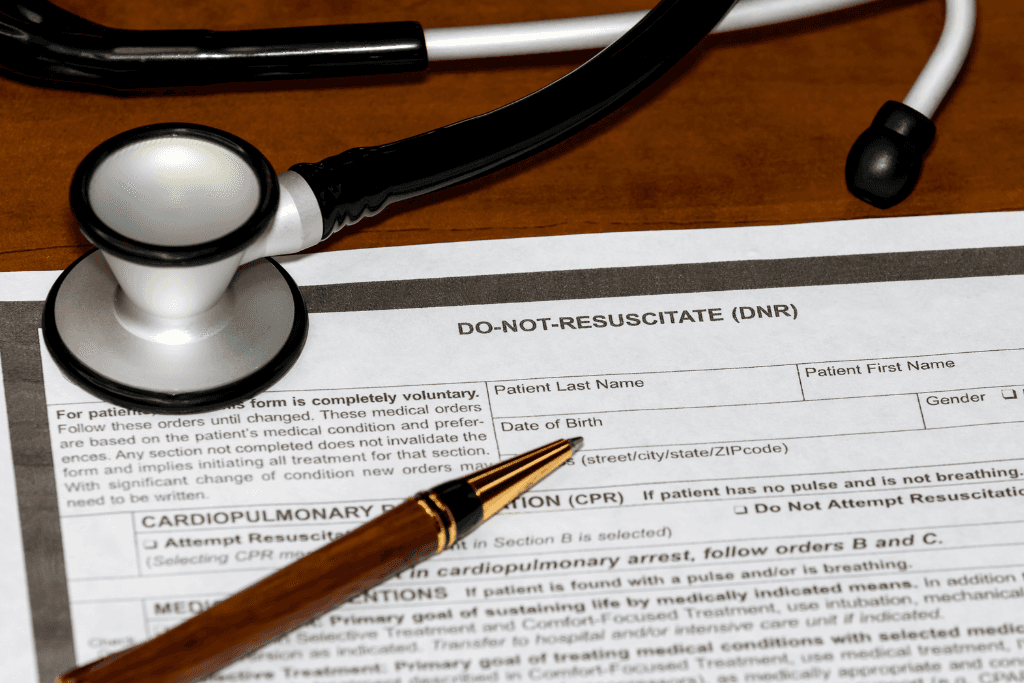Creating a do-not-resuscitate (DNR) order is one of the most significant decisions you'll ever make regarding your medical care. It's not something to rush into – this choice often follows hours of careful reflection and important conversations with your healthcare provider, spouse, or other family members. Once you've made the decision, it's crucial to ensure the DNR form is filled out correctly.
Even a small error on the form can invalidate the entire order, leaving your healthcare provider unable to follow your wishes. In this guide, we’ll show you how to avoid that by explaining where to find the form, how to complete it properly, and other essential details.
Key Takeaways
A DNR form contains your end-of-life wishes and, legally, cannot be ignored by healthcare providers.
A DNR form has your personal details, CPR preferences, and signatures from you and your healthcare provider.
Not filling out the whole form, using the wrong form, and not having all required signatures can result in an invalid DNR.
Steps to Fill Out a Do-Not-Resuscitate Form

Getting a copy of a DNR form is easy since they’re available for free through multiple platforms. You can easily and conveniently download DNR templates online through various websites like legaltemplates.net and eforms.com. You can also obtain a DNR from your healthcare providers by requesting a consultation with them.
Here are the steps for filling out a DNR form.
Consult with your healthcare provider: Once you make the decision to order a DNR, you will need to consult with your healthcare provider to discuss the realities of obtaining your DNR.
Obtain the DNR form: You can obtain the DNR form through the different methods already mentioned, but it’s a good idea to get it from your healthcare provider during the consultation.
Fill out your personal information: To start, you must complete your personal information on the form. This will include your full name, address, and your date of birth. You need to ensure this is correct, otherwise, your DNR won’t be valid.
Indicate your CPR wishes: On the form, you will have the opportunity to indicate your wishes regarding resuscitation. Some forms provide options for the refusal of CPR, mechanical ventilation, defibrillation, and others. If you have any questions, ask your healthcare provider for clarity and assistance.
Inform your healthcare proxy: If you appointed a medical power of attorney, you will need to discuss your DNR wishes with them as well.
Sign the DNR form: This is the important part. Different states have their own requirements you must be aware of to ensure your DNR is valid. For example, you may only need your and your healthcare provider’s signatures, or you may need additional signatures from witnesses.
Share copies: Once you complete the DNR form, your healthcare provider will distribute this information to other medical providers. You should also share this information with your family so they are aware of your end-of-life wishes.
After you fill out your DNR form, you must store it in a safe place like Trustworthy.
Trustworthy's award-winning Family Operating System® can be used to store all your end-of-life documents like your DNR. Trustworthy keeps your documents safe thanks to its world-class security practices and infrastructure, including 256-bit AES encryption and two-factor authentication, and it is compliant with HIPAA, a federal law that protects the privacy and security of health information.
Trustworthy’s collaboration features make it easy to share your DNR form with healthcare providers and your family.
Common Mistakes When Filling Out a DNR Form
Avoid complications and misunderstandings with your end-of-life wishes by avoiding these common mistakes.
Using the wrong form: Ensure you use the correct form for the state you live in.
Incomplete forms: Even just forgetting to complete a small section or piece of information can make your DNR invalid. Ensure you have filled out everything on the form.
No witnesses or lack of signatures: Every state has its own signature preferences, and failure to obtain the correct ones can mean your DNR is invalid.
Not distributing your forms: Filling out your DNR correctly is of no use to you if you have not informed your healthcare provider or loved ones of your decision.
Not reviewing your DNR: If your medical condition has changed and you no longer wish for a DNR but don’t revoke the order, this can have serious and fatal consequences.
Discussing DNR Wishes With Family and Healthcare Providers

Once you make your decision and fill out the DNR form, your next course of action is to discuss your end-of-life wishes with your family and healthcare providers.
During your consultation, you discuss your inventions with your healthcare provider, and generally, they pass this information on to your other healthcare providers and add it to your medical record.
Discussing your DNR wishes with your family might be a harder conversation, but it’s crucial. Be clear and direct about your intentions. Depending on your wishes, this may be hard for your loved ones to understand, and they may have questions or concerns. They don’t have to agree with your decision, but they must accept it.
Having a documented copy of your conversation with healthcare providers and your loved ones in writing is a great idea to ensure everyone is on the same page. You can store this document with Trustworthy and create a trusted network of people who have access to information at all times in case of an emergency.
Related: How to File a DNR Form
Storing and Accessing Your DNR Form
It’s important to keep your DNR order somewhere that is safe and easily accessible. This ensures all personnel caring for you during a medical emergency where you are incapacitated are aware of your end-of-life wishes.
Heidi Garvis, an aging life care consultant and certified senior advisor in Virginia, believes that one of the best places to keep your DNR form is a note on the fridge door. She explains: “What people don’t understand is that in a crisis situation, no one is going to look in a safe or a locked drawer. Plain sight is what works.”
Avoid storing your DNR somewhere that is not common, like an in-home safe. During an emergency, first responders may not know where it is or how to access it if you are incapacitated.
Some people choose to wear medical jewelry like bracelets and necklaces that inform healthcare providers and first responders that they have a DNR.
Storing physical copies puts the risk of misplacing or losing them at a higher chance. Take advantage of a secure digital storage platform like Trustworthy.
Trustworthy is a digital safe deposit box that can help keep important documents safe without the hassle of filing physical documents. With Trustworthy, you can ensure that your DNR is always accessible to those who need it, regardless of their location.
Frequently Asked Questions
Who should have a DNR form?
Anyone who wishes to create a DNR will need to fill out a form. Copies of this form will need to be shared with their healthcare provider, medical power of attorney as well as loved ones.
Do I need a lawyer to fill out a DNR form?
No, but you can require the assistance of a lawyer to explain the risks and benefits of a DNR.
Can I change or cancel my DNR once it’s done?
Yes, you can legally revoke or change your DNR at any time as long as you inform your healthcare provider of the changes immediately.
We’d love to hear from you! Feel free to email us with any questions, comments, or suggestions for future article topics.
Trustworthy is an online service providing legal forms and information. We are not a law firm and do not provide legal advice.














